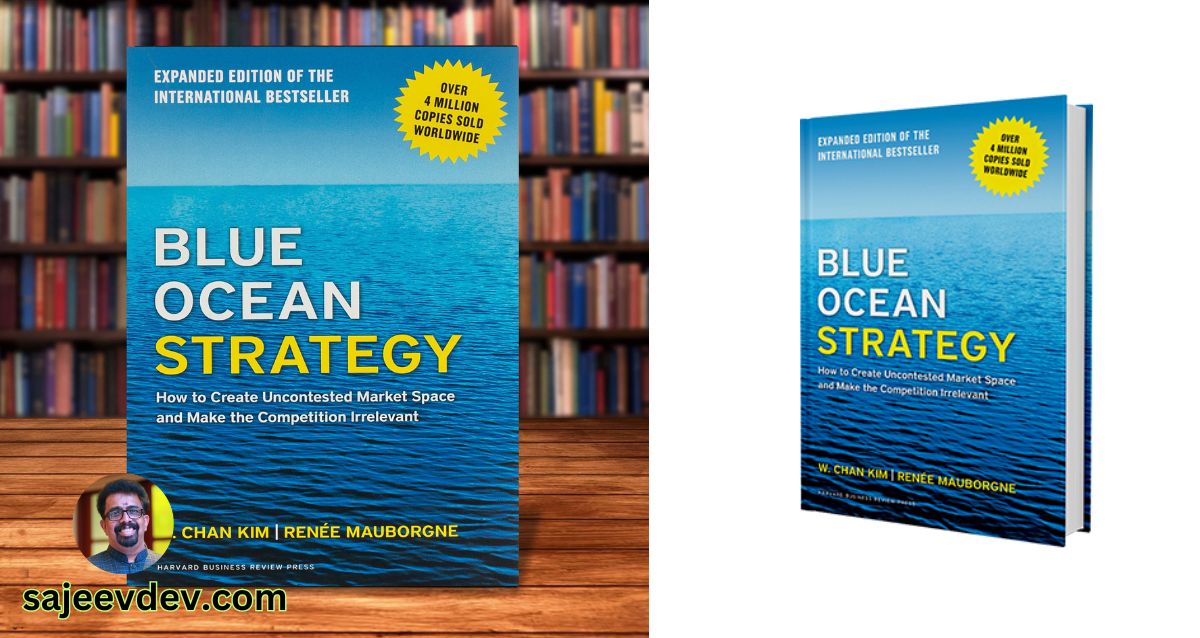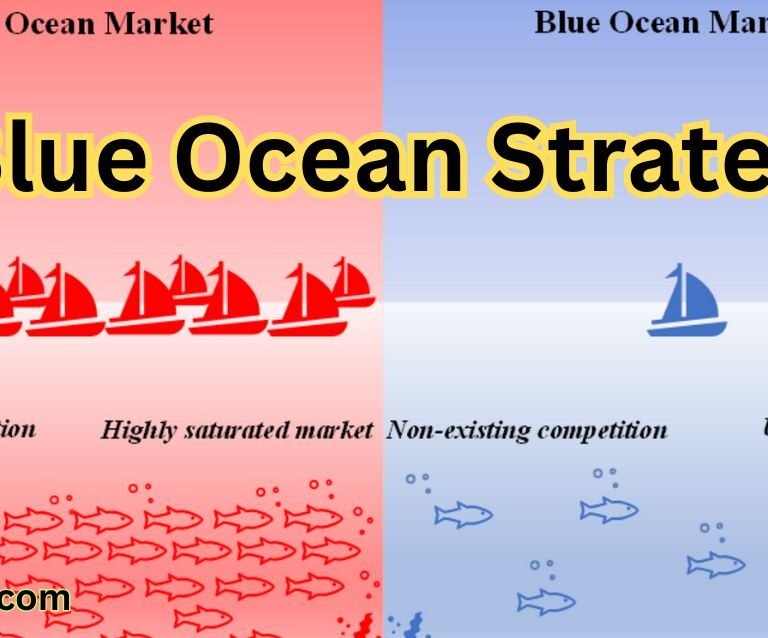The concept of Blue Ocean Strategy, introduced by W. Chan Kim and Renée Mauborgne in their groundbreaking book, revolutionizes traditional business thinking
The concept of Blue Ocean Strategy, introduced by W. Chan Kim and Renée Mauborgne in their groundbreaking book, revolutionizes traditional business thinking. This strategic framework advocates for the pursuit of untapped market opportunities, referred to as ‘blue oceans’, as opposed to the fiercely competitive environments known as ‘red oceans’. In red oceans, businesses compete within established industry boundaries, often leading to a bloody competition for market share where companies vie for a limited consumer pool. This competition typically results in diminishing returns and price wars, ultimately stifling innovation and profitability.
Blue Ocean Strategy, on the other hand, emphasizes the importance of creating new demand in an uncontested market space, thereby fostering innovation and value creation. By transcending traditional competition, organizations are encouraged to explore new avenues wherein they can differentiate their offerings and cater to unmet consumer needs. This approach not only enhances the potential for growth but also provides a sustainable competitive advantage. The authors identify several key principles underlying this strategy, including the focus on value innovation, which combines the two essential elements of differentiation and low cost.
Through this framework, companies can shift their focus from competing in crowded sectors to exploring less contested areas that align with their objectives and capabilities. The implications of adopting a Blue Ocean Strategy are profound, empowering businesses to enhance their offerings and unlock new avenues for profit and growth. As more companies recognize the limitations inherent in red ocean strategies, the principles articulated in Kim and Mauborgne’s work gain increasing relevance. This section sets the stage for a deeper understanding of how Blue Ocean Strategy can transform business landscapes and open doors to new possibilities.
Understanding Red Oceans vs. Blue Oceans
The concept of red oceans and blue oceans serves as a foundational difference in market strategy, primarily articulated in the framework known as Blue Ocean Strategy. Red oceans symbolize the cutthroat spaces of traditional industry, where organizations vie intensely for market share within established industries. Limited demand often leads to fierce competition, driving prices down and eroding profit margins, akin to the metaphorical blood that colors the water. In such saturated markets, companies find themselves engaged in a struggle for survival, frequently resorting to price wars and aggressive marketing tactics to outmaneuver rivals.
In stark contrast, blue oceans denote unexplored market spaces ripe with opportunity and minimal competition. Rather than competing within the confines of existing markets, the focus is on innovation and the creation of new demand. This strategic thinking encourages organizations to venture beyond conventional boundaries, fostering an environment where they can introduce novel products and services that cater to unmet customer needs. By striving to capture an entirely new customer base, businesses can redefine their market landscape, thus enjoying a fresh competitive advantage.
While both red and blue oceans represent significant business landscapes, their strategic implications differ substantially. A red ocean strategy often focuses on outperforming rivals to maintain market share, emphasizing operational efficiencies and incremental improvements. Conversely, a blue ocean strategy prioritizes value innovation, wherein the goal is not merely to beat the competition but to make it irrelevant through strategic differentiation and innovative offerings. By understanding these distinctions, organizations can better position themselves to navigate their market oceans, aligning their strategies with the need for growth and long-term sustainability.
The Concept of Value Innovation
Value innovation is a cornerstone of the Blue Ocean Strategy, as articulated in the pioneering work by W. Chan Kim and Renée Mauborgne. This strategic approach encourages organizations to prioritize innovation that creates new value in the marketplace, thereby redefining the competition landscape. By embracing value innovation, companies do not merely seek to outperform rivals in existing markets; they endeavor to create unoccupied market space, or “blue oceans,” characterized by new demand and reduced competition.
At the heart of value innovation lies the dual focus on differentiation and cost leadership. By simultaneously pursuing these two objectives, organizations can deliver unique products or services while simultaneously reducing operational expenses. This approach allows businesses to break the traditional trade-off between value and cost. For example, companies can identify and eliminate factors that are not essential to the customer, thereby streamlining their offerings and cutting unnecessary costs. Simultaneously, they can invest in features that deliver higher perceived value, thus appealing to a wider customer base.
The concept is exemplified by notable companies such as Cirque du Soleil, which revolutionized the circus industry by removing costly elements like animal acts and focusing on a theatrical experience. This innovative strategy attracted a different audience segment willing to pay a premium for a unique entertainment experience. In addition, value innovation can foster customer loyalty by continuously responding to emerging consumer needs and preferences, ensuring long-term sustainability and growth.
Ultimately, value innovation encapsulates a transformative approach that enables businesses to launch themselves into new realms of profitability. By understanding and applying the principles of value innovation, organizations can effectively enhance both their competitive advantage and customer satisfaction, leading to comprehensive success in diversified markets.
Exploring the Strategy Canvas
The strategy canvas is a foundational tool introduced by W. Chan Kim and Renée Mauborgne, designed to help businesses visualize their current competitive landscape in a structured manner. This approach facilitates a comprehensive understanding of the market dynamics that influence a company’s positioning relative to its competitors. At its core, the strategy canvas provides a graphical representation of a company’s strategic profile compared to those of existing competitors within the same industry.
By mapping out the key factors of competition relevant to an industry, the strategy canvas enables businesses to identify where they stand in relation to their competitors. It charts the level of offering across various dimensions, such as price, quality, features, and customer service, allowing companies to recognize the distribution of value among competitors. In doing so, businesses can pinpoint areas of saturation and, more critically, potential market gaps. This visualization is instrumental in uncovering emergent opportunities for differentiation, empowering organizations to move beyond traditional competitive constraints.
Additionally, the strategy canvas facilitates a comparative insight into what is deemed valuable by consumers. By analyzing these visual representations, companies can discern which strategic factors are essential to their target customers and which may be undervalued or overlooked by competitors. This understanding serves as a springboard for innovative strategies, enabling businesses to develop offerings that not only satisfy existing consumer demands but also create unique value propositions. Furthermore, the strategy canvas cultivates a culture of continual improvement and innovation, encouraging organizations to react swiftly to market changes and consumer preferences.
In essence, the strategy canvas plays a pivotal role in the blue ocean strategy framework by guiding businesses towards exploration of uncontested market spaces. Its ability to reveal unexploited opportunities equips companies with the insights necessary for crafting strategies that foster sustainable growth and competitive advantage.
The Four Actions Framework
The Four Actions Framework is a critical component of the Blue Ocean Strategy, enabling companies to redefine market boundaries and identify opportunities for innovation. This framework consists of four essential questions: eliminate, reduce, raise, and create. By systematically addressing these questions, organizations can uncover untapped consumer needs and develop offerings that stand out from the competition.
The first action, “eliminate,” suggests that businesses should identify which factors in their industry should be completely removed. This action prompts companies to scrutinize existing norms and practices that may no longer serve consumer needs or contribute to value creation. For example, a company in the airline industry might assess the need for unnecessary frills in service that do not significantly heighten customer satisfaction or loyalty, thus allowing a focus on more essential elements.
The second action, “reduce,” encourages firms to evaluate which factors can be diminished to enhance efficiency and cost-effectiveness. This may involve lowering unnecessary service levels or pricing strategies that do not add value for customers. A classic instance of this is seen in the budget airline model, where companies reduce amenities to offer lower fares, thereby capturing a market segment that prioritizes price over luxurious service options.
Finally, the question of “create” compels firms to explore entirely new avenues for adding value, which can manifest through innovation in products, services, or business models. By pioneering unique propositions, companies can cater to previously unaddressed consumer segments, establishing themselves as leaders in a newly defined market space. Together, these four actions help organizations effectively navigate their strategic landscape in pursuit of growth and differentiation.
The Six Paths Framework for Strategic Exploration
The Blue Ocean Strategy presents a compelling framework for organizations seeking growth and innovation beyond the constraints of existing markets, often referred to as red oceans. At the core of this strategy lies the Six Paths Framework, which facilitates strategic exploration by guiding businesses toward untapped market space. These paths instruct companies to rethink their approach and broaden their strategic focus, allowing them to discover new opportunities and redefine their competitive landscape.
The first path encourages organizations to look across alternative industries. By examining what drives consumers to make choices within different sectors, companies can identify innovative ways to attract new customers and provide unique value. The second path involves exploring strategic groups within industries. This entails analyzing the competition within various tiers of a sector to uncover weaknesses that can be exploited, thereby creating differentiated offerings that cater to overlooked segments.
The third path focuses on addressing buyer groups. Companies are urged to consider the needs and preferences of buyers beyond the conventional target segments. Here, businesses can identify unmet needs, leading to new product development that resonates more strongly with end users. In the fourth path, firms are encouraged to examine the chain of buyers. By understanding the entire buyer journey, companies can enhance their value proposition and foster deeper customer loyalty.
The fifth path revolves around complementary product and service offerings. By thoughtfully adding complementary services or products, companies can enhance the customer experience and switch consumer preference in their favor. Finally, the sixth path urges businesses to rethink the functional-emotional orientation of their offerings. Companies must explore how they can provide emotional satisfaction alongside functionality, ultimately differentiating themselves in the minds of consumers. By utilizing the Six Paths Framework, organizations can successfully navigate out of crowded red oceans, unlocking new market opportunities and achieving sustainable growth.
Real-World Applications and Case Studies
The Blue Ocean Strategy has been selectively embraced by various organizations across multiple industries, leading to significant market disruptions and innovative breakthroughs. One of the most frequently cited examples is Cirque du Soleil, which redefined the circus industry by eliminating traditional elements such as expensive animal acts while enhancing the overall experience through theatrical storytelling. By targeting a completely new audience of adults and corporate clients rather than focusing solely on children and families, Cirque du Soleil created a blue ocean where they achieved unprecedented ticket sales and profitability.
Another illustrative case is Apple’s launch of the iTunes store. Prior to its inception, the music industry faced challenges associated with piracy and rampant illegal downloads. By offering a legal platform that allowed consumers to purchase individual songs at an affordable price, Apple unlocked a new market segment. This initiative not only transformed the way people consumed music but also attracted a plethora of content creators, turning iTunes into a substantial revenue generator for the company and its partners.
In the healthcare sector, the health club chain, Anytime Fitness, exemplifies the application of Blue Ocean Strategy principles. This company recognized that many individuals were deterred from joining traditional gyms due to restrictive hours and cumbersome contracts. By offering 24/7 access to its facilities and a month-to-month membership model, Anytime Fitness catered to those seeking convenience and flexibility. As a result, the chain has grown to thousands of locations worldwide, showcasing the efficacy of targeting unmet customer needs.
These case studies underscore the versatility of the Blue Ocean Strategy across different sectors. Companies that successfully identify and tap into unserved market spaces can achieve superior growth and sustained competitive advantage, fundamentally altering their industry landscapes. The principles of this strategy continue to guide organizations looking to innovate and thrive in an increasingly crowded marketplace.
Challenges in Implementing Blue Ocean Strategy
Implementing the Blue Ocean Strategy can present various challenges that businesses must navigate to achieve a successful transition. One significant hurdle is resistance to change within the organization. Employees and management may be accustomed to traditional competitive approaches, which can foster a mindset focused on outperforming rivals rather than exploring untapped markets. This resistance can stem from fear of the unknown, a lack of understanding of the strategy, or concerns about job security. Effective leadership and communication are vital in addressing these apprehensions and guiding the organization toward embracing innovation.
Another challenge is the tendency for companies to adopt a short-term focus. In many instances, organizations prioritize immediate financial performance, driven by shareholder expectations. This short-sightedness can hinder the exploration of new market spaces that may not yield immediate returns. Blue Ocean Strategy, however, encourages a long-term vision aimed at creating sustainable growth and value creation. To overcome this challenge, businesses must instill a culture that values vision and encourages sustained investment in innovative initiatives, even at the expense of short-term gains.
Additionally, shifting mindsets from competition to innovation can prove to be difficult for many organizations. Employees may struggle to let go of ingrained practices centered around rivalry, as these methods have historically dictated business success. Emphasizing a collaborative culture and encouraging creative thinking will be crucial in facilitating this transition. By fostering an environment conducive to ideation and experimentation, organizations can cultivate the necessary mindset shift to identify and pursue blue ocean opportunities effectively.
In conclusion, while the Blue Ocean Strategy offers significant potential for businesses willing to explore new markets, understanding and addressing resistance to change, short-term focus, and cognitive barriers is essential for a successful implementation.
The Future of Business Strategy
As organizations navigate the complexities of today’s dynamic marketplace, it is evident that the principles of Blue Ocean Strategy are inducing a paradigm shift in business practices. The traditional approach of competing within defined markets often results in intensified rivalry, price wars, and diminished margins. In contrast, Blue Ocean Strategy encourages businesses to shift their focus from competing to innovating and creating uncontested market spaces. This transformative impact empowers companies to break free from the constraints of traditional competition, opening up new avenues for growth and customer engagement.
The application of Blue Ocean Strategy offers a strategic framework that prioritizes value innovation. This approach not only addresses the needs of existing customers but also taps into the latent demand of new audiences. As businesses increasingly recognize the limitations of saturated markets, the emphasis will continue to shift towards developing blue oceans—spaces ripe for untapped customer bases and innovative products. By fostering an environment where creativity and strategic thinking thrive, companies are better positioned to adapt and lead in their respective industries.
Looking forward, it is crucial for businesses to understand that success in the future landscape will not solely depend on outperforming competitors but rather on redefining the competitive playing field altogether. This shift will demand a commitment to continuous learning, exploration, and the courage to venture into the unknown. As organizations embrace the tenets of Blue Ocean Strategy, those that remain steadfast in their commitment to innovation are likely to not only thrive but also set new standards in their industries.
In conclusion, the future of business strategy lies in the hands of those willing to explore new opportunities and create value in novel ways. By adopting a Blue Ocean mindset, organizations can shape their destinies and establish themselves as leaders in a rapidly evolving economic landscape.









